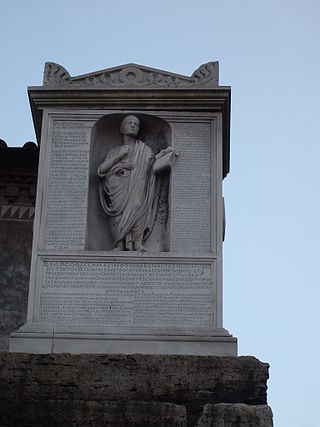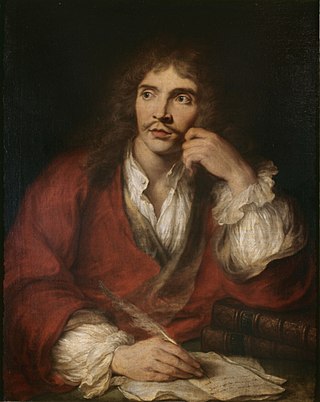Related Research Articles
Free verse is an open form of poetry, which in its modern form arose through the French vers libre form. It does not use consistent meter patterns, rhyme, or any musical pattern. It thus tends to follow the rhythm of natural speech.

In poetry, a hendecasyllable is a line of eleven syllables. The term may refer to several different poetic meters, the older of which are quantitative and used chiefly in classical poetry, and the newer of which are syllabic or accentual-syllabic and used in medieval and modern poetry.
In poetry, metre or meter is the basic rhythmic structure of a verse or lines in verse. Many traditional verse forms prescribe a specific verse metre, or a certain set of metres alternating in a particular order. The study and the actual use of metres and forms of versification are both known as prosody.

Poetry, also called verse, is a form of literature that uses aesthetic and often rhythmic qualities of language − such as phonaesthetics, sound symbolism, and metre − to evoke meanings in addition to, or in place of, a prosaic ostensible meaning. A poem is a literary composition, written by a poet, using this principle.
A strophe is a poetic term originally referring to the first part of the ode in Ancient Greek tragedy, followed by the antistrophe and epode. The term has been extended to also mean a structural division of a poem containing stanzas of varying line length. Strophic poetry is to be contrasted with poems composed line-by-line non-stanzaically, such as Greek epic poems or English blank verse, to which the term stichic applies.

In prosody, alliterative verse is a form of verse that uses alliteration as the principle device to indicate the underlying metrical structure, as opposed to other devices such as rhyme. The most commonly studied traditions of alliterative verse are those found in the oldest literature of the Germanic languages, where scholars use the term 'alliterative poetry' rather broadly to indicate a tradition which not only shares alliteration as its primary ornament but also certain metrical characteristics. The Old English epic Beowulf, as well as most other Old English poetry, the Old High German Muspilli, the Old Saxon Heliand, the Old Norse Poetic Edda, and many Middle English poems such as Piers Plowman, Sir Gawain and the Green Knight, Layamon's Brut and the Alliterative Morte Arthur all use alliterative verse.

The Sapphic stanza, named after Sappho, is an Aeolic verse form of four lines. Originally composed in quantitative verse and unrhymed, since the Middle Ages imitations of the form typically feature rhyme and accentual prosody. It is "the longest lived of the Classical lyric strophes in the West".

A dactyl is a foot in poetic meter. In quantitative verse, often used in Greek or Latin, a dactyl is a long syllable followed by two short syllables, as determined by syllable weight. The best-known use of dactylic verse is in the epics attributed to the Greek poet Homer, the Iliad and the Odyssey. In accentual verse, often used in English, a dactyl is a stressed syllable followed by two unstressed syllables—the opposite is the anapaest.

Michael Dana Gioia is an American poet, literary critic, literary translator, and essayist.
Scansion, or a system of scansion, is the method or practice of determining and (usually) graphically representing the metrical pattern of a line of verse. In classical poetry, these patterns are quantitative based on the different lengths of each syllable. In English poetry, they are based on the different levels of stress placed on each syllable. In both cases, the meter often has a regular foot. Over the years, many systems have been established to mark the scansion of a poem.
Iambic pentameter is a type of metric line used in traditional English poetry and verse drama. The term describes the rhythm, or meter, established by the words in each line. Rhythm is measured in small groups of syllables called "feet". "Iambic" indicates that the type of foot used is the iamb, which in English is an unstressed syllable followed by a stressed syllable. "Pentameter" indicates that each line has five "feet".

The history of Latin poetry can be understood as the adaptation of Greek models. The verse comedies of Plautus, the earliest surviving examples of Latin literature, are estimated to have been composed around 205-184 BC.
New Formalism is a late 20th- and early 21st-century movement in American poetry that has promoted a return to metrical, rhymed verse and narrative poetry on the grounds that all three are necessary if American poetry is to compete with novels and regain its former popularity among the American people.
Accentual-syllabic verse is an extension of accentual verse which fixes both the number of stresses and syllables within a line or stanza. Accentual-syllabic verse is highly regular and therefore easily scannable. Usually, either one metrical foot, or a specific pattern of metrical feet, is used throughout the entire poem; thus one can speak about a poem being in, for example, iambic pentameter. Poets naturally vary the rhythm of their lines, using devices such as inversion, elision, masculine and feminine endings, the caesura, using secondary stress, the addition of extra-metrical syllables, or the omission of syllables, the substitution of one foot for another.
This is a glossary of poetry terms.

H.T. or Tom Kirby-Smith is an American author and poet.

Annie Finch is an American poet, critic, editor, translator, playwright, and performer and the editor of the first major anthology of literature about abortion. Her poetry is known for its often incantatory use of rhythm, meter, and poetic form and for its themes of feminism, witchcraft, goddesses, and earth-based spirituality. Her books include The Poetry Witch Little Book of Spells, Spells: New and Selected Poems, The Body of Poetry: Essays on Women, Form, and the Poetic Self, A Poet's Craft, Calendars, and Among the Goddesses.
Aeolic verse is a classification of Ancient Greek lyric poetry referring to the distinct verse forms characteristic of the two great poets of Archaic Lesbos, Sappho and Alcaeus, who composed in their native Aeolic dialect. These verse forms were taken up and developed by later Greek and Roman poets and some modern European poets.
Latin prosody is the study of Latin poetry and its laws of meter. The following article provides an overview of those laws as practised by Latin poets in the late Roman Republic and early Roman Empire, with verses by Catullus, Horace, Virgil and Ovid as models. Except for the early Saturnian poetry, which may have been accentual, Latin poets borrowed all their verse forms from the Greeks, despite significant differences between the two languages.

The French alexandrine is a syllabic poetic metre of 12 syllables with a medial caesura dividing the line into two hemistichs (half-lines) of six syllables each. It was the dominant long line of French poetry from the 17th through the 19th century, and influenced many other European literatures which developed alexandrines of their own.
References
- ↑ Brogan, T. V. F. "New Formalism." The New Princeton Encyclopedia of Poetry and Poetics, eds. Alex Preminger and T. V. F. Brogan. Princeton: Princeton Univ. Press, 1993, p. 835.
- 1 2 "Timothy Steele". www.poetryfoundation.org. Poetry Foundation. 18 May 2023. Archived from the original on October 3, 2018. Retrieved 19 May 2023.
- ↑ Leithauser, Brad. "The Strictest Line." TLS, February 19, 1988, p. 180.
- ↑ "Timothy Steele in Conversation with Cynthia Haven." Three Poets in Conversation: Dick Davis, Rachel Hadas, Timothy Steele. London: Between the Lines, 2006, pp. 103-06.
- ↑ Steele, Timothy. "The Forms of Poetry." Brandeis Review (Summer 1992), pp. 29-30.
- ↑ "Faculty Web Directory".
- ↑ Kennedy, X. J. "Timothy Steele." Dictionary of Literary Biography, Vol. 120: American Poets Since World War II, ed. R. S. Gwynn. Detroit: Gale, 1992, p. 298.
- ↑ Fure, Rob. Library Journal, April 15, 1979, p. 956.
- ↑ Hellerstein, Kathryn. "Pleasures of Restriction." Partisan Review (Autumn 1989), p. 679.
- ↑ Gwynn, R. S. "Lectures in Urban Survival." The Sewanee Review (Winter 1996), p. vii.
- ↑ Olson, Ray. Booklist, March 1, 2006. http://www.ohioswallow.com/review/663. Retrieved 8 December 2011.
- ↑ Sheehy, Donald G. "Measure for Measure: The Frostian Classicism of Timothy Steele." The Robert Frost Journal (Fall 1995) p. 73.
- ↑ Gordon, Larry. "Poetry's Purist." Los Angeles Times, June 10, 1991, Section B, p. 1.
- ↑ Wilmer, Clive. "A Straitjacket or a Trilby?" TLS, February 1, 1991, p. 19.
- ↑ Steele. Contribution to "Symposium: What We Talk about When We Talk about Form." Think Journal (2011), p. 14.
- ↑ Shaw, Robert B. "Prosody for the People." Poetry (September 2000), p. 347.
- ↑ Walzer, Kevin. "The Poetry of Timothy Steele." The Tennessee Quarterly (Winter 1996), p. 17.
- ↑ Aimone, Joseph O. "Timothy Steele." Dictionary of Literary Biography, Vol. 282: New Formalist Poets, eds. Jonathan N. Barron and Bruce Meyer. Farmington Hills, Michigan: Gale, 2003, p. 292.
- ↑ Imbarrato, Susan Clair. "Timothy Reid Steele." The Greenwood Encyclopedia of American Poets and Poetry, ed. Jeffrey Gray. Westport, Connecticut: Greenwood Press, 2006, vol. 5, p. 1522.
- ↑ WorldCat. OCLC 1033791424.